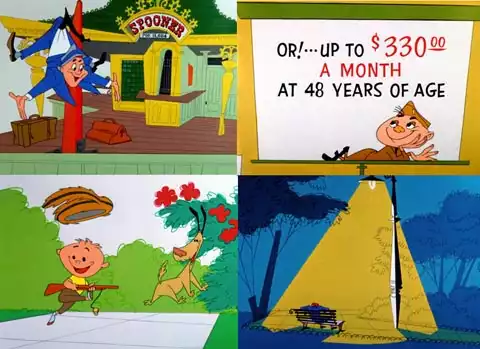Oct 2, 2012
The Wonders of 90 Days, by Chuck Jones.
Since my post about Chuck Jones' 1955 short story "A Hitch in Time" was so well received, I'll complete the story: 1956's "90 Day Wondering" and 1957's "Drafty, Isn't It-."
The gem of the two is probably "90 Day Wondering". I had seen some of Maurice Noble's layout concepts for this short while researching the book Cartoon Modern, but alas, I had not seen this short. It is an absolutely stunning example of the "Cartoon Modern" aesthetic, with an astounding level of skill that goes far beyond the necessity of the mundane ideas expressed in the film.
The first minute is a masterful piece of temporal and spatial compression. It follows the protagonist's ecstatic journey out of the army and back home, running around in circles like a Tasmanian Devil. The film also makes good use of animated movement to express the character's inner emotions.
When the protagonist finally appears before the audience, he has arrived in his hometown of Spooner. Spooner is also the birthplace of Maurice Noble (Spooner Township, Minnesota). Noble is at the peak of his layout powers in this short story. He plays freely with the exaggeration of background shapes, perspective, patterns, and colors, and thinks nothing of using full color in some of the backgrounds while using stark white backgrounds in other scenes of the film.
The main character, Ralphie, is designed so realistically that it is hard to believe that this is a Warner Bros. cartoon, which is a direct result of the fact that the purpose of the cartoon was first and foremost to convince military personnel to re-enlist. Ralphy's realistic design also provides a stunning contrast to the cartoon characters, Pete and Re-Pete, who serve as his conscience.
Even after all this time, it is a thrill to discover new Chuck Jones cartoons from the 50s. It's also educational. Watching a Jones film you've never seen allows you to look objectively at its quality in a way that Jones' classic shorts, which you've seen dozens of times, can't.
This trio of military propaganda shorts by Jones is phenomenally impressive. Jones' crew brings a level of expertise and professionalism that is sorely lacking (dare I say, entirely lacking) in much of today's cartoon animation. If anything, it serves as a reminder that almost any idea or concept can be enhanced by animation if it is entrusted to filmmakers who are passionate about the craft of visual storytelling.




Post your comment